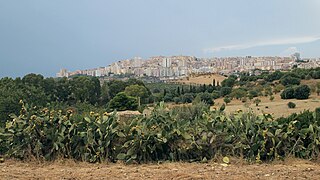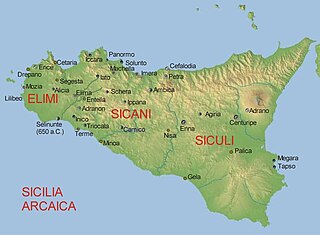Related Research Articles

Agrigento is a city on the southern coast of Sicily, Italy and capital of the province of Agrigento. It was one of the leading cities of Magna Graecia during the golden age of Ancient Greece with population estimates in the range of 200,000 to 800,000 before 406 BC.

Magna Graecia was the name given by the Romans to the coastal areas of Southern Italy in the present-day Italian regions of Campania, Apulia, Basilicata, Calabria and Sicily; these regions were extensively populated by Greek settlers. These settlers, who began arriving in the 8th century BC, brought with them their Hellenic civilization, which left a lasting imprint on Italy. They also influenced the native peoples, such as the Sicels and the Oenotrians, who became hellenized after they adopted the Greek culture as their own.

Ancient Hawaiʻi is the period of Hawaiian history preceding the unification in 1810 of the Kingdom of Hawaiʻi by Kamehameha the Great. Traditionally, researchers estimated the first settlement of the Hawaiian islands as having occurred sporadically between 400 and 1100 CE by Polynesian long-distance navigators from the Samoan, Marquesas, and Tahiti islands within what is now French Polynesia. In 2010, a study was published based on radiocarbon dating of more reliable samples which suggests that the islands were settled much later, within a short timeframe, in about 1219 to 1266.

Enna, known until 1926 as Castrogiovanni, is a city and comune located roughly at the center of Sicily, southern Italy, in the province of Enna, towering above the surrounding countryside. It has earned the nicknames belvedere and ombelico ("navel") of Sicily.
Archaeology is the study of human activity in the past, primarily through the recovery and analysis of the material culture and environmental data that they have left behind, which includes artifacts, architecture, biofacts and cultural landscapes.

Halyciae is the ancient name for one of the settlements of the Elymians on the island of Sicily, known as Alicia in more recent Italian scholarship.

Morgantina is an archaeological site in east central Sicily, southern Italy. It is sixty kilometres from the coast of the Ionian Sea, in the province of Enna. The closest modern town is Aidone, two kilometres southwest of the site. The site consists of a two-kilometre long ridge running southwest-northeast, known as Serra Orlando, and a neighboring hill at the northeast called Cittadella. Morgantina was inhabited in several periods. The earliest major settlement was made at Cittadella and lasted from about 1000/900 to about 450 BCE. The other major settlement was located on Serra Orlando, and existed from about 450 BCE to about 50 CE. Morgantina has been the subject of archaeological investigation since the early 20th century.

Teppe Hasanlu or Tappeh Hassanlu is an archeological site of an ancient city located in northwest Iran, a short distance south of Lake Urmia. The nature of its destruction at the end of the 9th century BCE essentially froze one layer of the city in time, providing researchers with extremely well preserved buildings, artifacts, and skeletal remains from the victims and enemy combatants of the attack.

Motya was an ancient and powerful city on San Pantaleo Island off the west coast of Sicily, in the Stagnone Lagoon between Drepanum and Lilybaeum. It is within the present-day commune of Marsala, Italy.
Caroline Malone is a British academic and archaeologist, former Professor of Prehistory at Queen's University, Belfast School of Natural and Built Environment http://www.qub.ac.uk/schools/nbe/, and formerly Senior Tutor of Hughes Hall, Cambridge, UK. Prior to this she was editor of Antiquity and Keeper of the Department of Prehistory and Early Europe at the British Museum. She began her career as curator at the Alexander Keillor Museum at Avebury.

Faiyum is a city in Middle Egypt. Located 100 kilometres southwest of Cairo, in the Faiyum Oasis, it is the capital of the modern Faiyum Governorate. Originally called Shedet in Egyptian, the Greeks called it in Koinē Greek: Κροκοδειλόπολις, romanized: Krokodilópolis, and later Medieval Greek: Ἀρσινόη, romanized: Arsinoë. It is one of Egypt's oldest cities due to its strategic location.

Kwang-chih Chang, commonly known as K. C. Chang, was a Chinese / Taiwanese-American archaeologist and sinologist. He was the John E. Hudson Professor of archaeology at Harvard University, Vice-President of the Academia Sinica, and a curator at the Peabody Museum of Archaeology and Ethnology. He helped to bring modern, western methods of archaeology to the study of ancient Chinese history. He also introduced new discoveries in Chinese archaeology to western audiences by translating works from Chinese to English. He pioneered the study of Taiwanese archaeology, encouraged multi-disciplinal anthropological archaeological research, and urged archaeologists to conceive of East Asian prehistory as a pluralistic whole.

Salemi is a town and comune in South-Western Sicily, Italy, administratively part of the province of Trapani.
Monte Polizzo is an archaeological site located 6 km northwest of the town of Salemi, in the province of Trapani, western Sicily, southern Italy. It occupies an easily defended hilltop, from which a vast area of western Sicily can be seen, and consists of an interconnected group of ridges, the highest point of which is 725.9 m (2359 feet) above sea level. The settlement has been dated to c. 9th - 4th centuries BC.
Patrick Vinton Kirch is an American archaeologist and Professor Emeritus of Integrative Biology and the Class of 1954 Professor of Anthropology at the University of California, Berkeley. Concurrently, he is professor in the department of anthropology at the University of Hawai'i Manoa. The former Curator of Oceanic Archaeology in the Phoebe A. Hearst Museum of Anthropology, and director of that museum from 1999 to 2002, he is a member of the board of directors of the Bishop Museum.
Pakistani architecture is intertwined with the architecture of the broader Indian subcontinent. With the beginning of the Indus civilization around the middle of the 3rd millennium BC, for the first time in the area which encompasses today's Pakistan an advanced urban culture developed with large structural facilities, some of which survive to this day. This was followed by the Gandhara style of Buddhist architecture that borrowed elements from Ancient Greece. These remnants are visible in the Gandhara capital of Taxila.

Archaeology or archeology is the scientific study of human activity through the recovery and analysis of material culture. The archaeological record consists of artifacts, architecture, biofacts or ecofacts, sites, and cultural landscapes. Archaeology can be considered both a social science and a branch of the humanities. In Europe it is often viewed as either a discipline in its own right or a sub-field of other disciplines, while in North America archaeology is a sub-field of anthropology.
Paul A. Shackel is an American anthropologist and a Professor of Anthropology in the Department of Anthropology at the University of Maryland, College Park. He joined the Department of Anthropology in 1996 after working for the National Park Service for seven and a half years. His research interests include Historical Archaeology, Civic Engagement, African Diaspora, Labor Archaeology, and Heritage Studies. He teaches courses in Historical Archaeology, Archaeology of the Chesapeake, and Method and Theory in Archaeology.

Tas-Silġ is a rounded hilltop on the south-east coast of the island of Malta, overlooking Marsaxlokk Bay, and close to the town of Żejtun. Tas-Silġ is a major multi-period sanctuary site with archaeological remains covering four thousand years, from the neolithic to the ninth century AD. The site includes a megalithic temple complex dating from the early third millennium BC, to a Phoenician and Punic sanctuary dedicated to the goddess Astarte. During the Roman era, the site became an international religious complex dedicated to the goddess Juno, helped by its location along major maritime trading routes, with the site being mentioned by first-century BC orator Cicero.
Miriam T. Stark is an American archaeologist whose field experience and emphasis of studies have included locations in North America, the Near East and Southeast Asia. She is currently a professor of Southeast Asian Archaeology at the University of Hawai’i-Manoa, a position she has held since August 1995. Having first received her B.A. from the University of Michigan, she went on to complete her M.A and PhD from the University of Arizona. Stark has co-directed the Lower Mekong Archaeological Project (LOMAP), located in southern Cambodia for the past 12 years. Her research focus not only includes the various aspects of political economy, but also on the process of state formation.
References
- ↑ Discovery Channel :: News - History :: Maui Temples Reveal Polynesian Past Archived May 20, 2011, at the Wayback Machine
- ↑ The Salemi Survey Project
- ↑ The LBA and EIA Landscape
- ↑ The Lost Settlement of Halikyai
- ↑ NIU archaeologist, students uncover possible medieval mosque in Sicily - NIU - Office of Public Affairs Archived December 18, 2010, at the Wayback Machine